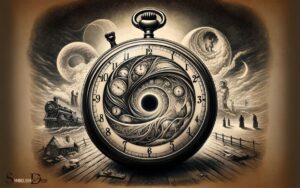What is the Meaning of Symbol in Literature? Explained!
A symbol in literature is a character, object, or action that represents something beyond its literal meaning.
It is a figurative device that communicates complex ideas and emotions, contributing to the depth and richness of a story.
In literature, authors often use symbols to imply ideas and create deeper significance.
These symbols can convey profound meanings, adding layers to the characters, plot, and themes.
The symbol can be a person, object, situation, action, or some other element that has a literal meaning in the story but is designed to represent something else.
In essence, symbols in literature serve to convey complex ideas and emotions in a more digestible and intriguing manner.
They add depth and dimension to a narrative, offering readers a richer, more layered reading experience. They are the silent whispers of a story, hinting at the unspoken and the unseen.
10 Symbols Meanings in Literature
| Symbol | Meaning in Literature |
|---|---|
| Rose | Often symbolizes love, beauty, femininity, or romanticism |
| Dove | Typically represents peace, purity, or innocence |
| Owl | Frequently signifies wisdom, knowledge, or mystery |
| Snake | Commonly symbolizes evil, danger, or deceit |
| Mirror | Can symbolize self-reflection, truth, or vanity |
| Fire | Often represents destruction, passion, or transformation |
| Ocean | Frequently symbolizes the unconscious, the unknown, or eternity |
| Bridge | Can symbolize transition, crossing, or change |
| Mountain | Often signifies obstacles, challenges, or high aspirations |
| Forest | Typically represents mystery, the unknown, or nature |
Key Takeaway

Five Facts About: The Use of Symbols in Literature
The Definition And Significance Of Symbolism In Literature
The Basics: What Is Symbolism?
Symbolism is a literary device that uses symbols, images, or objects to represent abstract ideas or concepts.
These symbols can be subtle or overt and can be found in various forms of literature like poems, novels, and short stories.
The purpose of symbolism is to enhance the literary work’s meaning, adding depth and richness to the story.
Symbolism As A Literary Device
Symbolism is one of the most commonly used literary devices in literature. It allows writers to create complex meanings and allusions through the use of simple and concrete images.
Symbolism can be found in characters, objects, settings, and events, and it helps to create deeper connections between the text and the reader.
Some examples of symbolism in literature include:
- The use of a mockingbird to symbolize innocence in harper lee’s to kill a mockingbird.
- The green light in f. scott fitzgerald’s the great gatsby symbolizes hope and the american dream.
- The red hunting hat in j.d. Salinger’s the catcher in the rye represents holden caulfield’s uniqueness and individuality.
Purpose Of Symbolism In Literature
Symbolism serves many purposes in literature.
It can be used to:
- Create deeper meaning and emotion in a literary work.
- Help readers connect with the story and its characters on a more profound level.
- Convey complex ideas and concepts in a simple and understandable way.
- Engage readers and encourage them to think critically about the text.
Symbolism can be used to convey various themes and messages in literature, including love, death, innocence, and power.
Historical Significance Of Symbolism In Literature
Symbolism has a rich history in literature, particularly in the late 19th and early 20th centuries.
Symbolism was a reaction against naturalism and realism, which emphasized factual and objective representations of the world.
Symbolists believed that art should be subjective and expressive, using symbols and metaphors to convey inner truths.
Prominent symbolist writers include charles baudelaire, arthur rimbaud, and stephane mallarme.
Symbolism has continued to influence literature throughout the 20th and 21st centuries, with writers like james joyce, william faulkner, and toni morrison using symbolism in their works.
Types Of Literary Symbols And Their Meaning
Archetypal Symbols And Their Meanings
Archetypal symbols, also known as universal symbols, are those that have been present in literature and art throughout the ages and across various cultures.
Here are some examples:
- The tree of life: Symbolizes growth and renewal, and is often associated with immortality.
- The hero: Represents bravery, sacrifice, and the triumph of good over evil.
- The trickster: Embodies mischief, cleverness, and deceit.
- The mother: Symbolizes nurturing, protection, and fertility.
- The shadow: Represents the unknown, the dark side of human nature, and the repressed aspects of the psyche.
Archetypal symbols are often used to explore universal themes and human experiences, such as the journey of self-discovery and the meaning of life.
Cultural Symbols And Their Meanings
Cultural symbols are specific to a particular group or society and may not necessarily be understood by others outside of that cultural context.
Some examples of cultural symbols include:
- The yin-yang: A symbol from chinese philosophy representing balance, harmony, and the interdependent nature of all things.
- The star of david: A symbol of jewish identity and faith, consisting of two interlocking triangles.
- The om: A sacred sound and symbol in hinduism, representing the universe and the ultimate reality.
Cultural symbols can offer insight into the values, beliefs, and traditions of a particular group or society.
Universal Symbols And Their Meanings
Universal symbols are those that have a universally recognized meaning across different cultures and societies.
Some examples of universal symbols include:
- The heart: Represents love, affection, and emotion.
- The cross: Symbolizes sacrifice, redemption, and resurrection.
- The sun: Represents life, energy, and power.
- The moon: Symbolizes femininity, intuition, and cyclical nature.
Universal symbols often have deep-rooted and often subconscious meanings that can be evocative and emotionally resonant.
Motifs And Their Significance
Motifs are recurring elements or ideas throughout a work of literature that contribute to its overall meaning and significance.
Some common motifs in literature include:
- Death and rebirth: Symbolizing the cyclical nature of life and the possibility of transformation.
- Nature: Often representing the beauty and power of the natural world, as well as the human relationship with the environment.
- Journey: Symbolizing the process of self-discovery and growth.
Motifs can deepen the reader’s understanding of a work of literature and offer insight into its underlying themes.
Interpreting Symbolic Themes In Literature
Symbolism in literature can add depth and meaning to a text that is not immediately apparent.
Interpreting symbolic themes is an essential part of understanding the author’s intent and message. Each symbol is unique, with its own meaning, context, and interpretation.
Common Symbols Used In Literature
Many common symbols appear in literature. Understanding their meaning is essential to interpreting the text.
Here are a few examples:
- The color red: Symbolism represents passion, love, and anger.
- The dove: Represents peace.
- The snake: Represents temptation or evil.
- The mirror: Represents self-reflection or introspection.
The Role Of Context In Interpreting Symbols
The context in which a symbol appears is essential to understanding its meaning. Different symbols can have different interpretations depending on the context.
For example, the color red can represent love if it appears in a romantic context but can represent anger if it appears in an argument between two characters.
Symbolism In Different Genres: Poetry, Novels, And Plays
Symbolism is a common literary device used in poetry, novels, and plays. In poetry, symbols are often used to express abstract ideas or emotions. In novels, symbols are often used to represent themes or characters.
In plays, symbols can be used to represent stage props or costumes.
Techniques For Analyzing Symbolic Themes
Analyzing symbolic themes requires careful attention to detail and context.
Here are a few techniques for analyzing symbolic themes:
- Identify all the symbols in the text and note their context and meanings.
- Group symbols by their meaning and purpose.
- Analyze how the symbols interact with each other and with the characters.
Understanding the symbolic themes in literature can deepen your appreciation of the text and give you insight into the author’s intent and message.
Symbolic Practices In Selected Classic Literature
Symbolism is a powerful literary device in literature that can convey deep meanings, emotions, and themes.
It is the use of symbolic elements such as objects, characters, colors, or events to represent something abstract or beyond the literary work’s literal meaning.
In this section, we will explore symbolic practices in selected classic literature.
William Golding’S The Lord Of The Flies
The lord of the flies is a classic novel that has captivated readers for decades, offering multifaceted interpretations surrounding the symbolic use of objects and characters.
Here are some key symbolic elements in the novel:
- The conch shell: Represents democracy, order, and civilization.
- The beast: Symbolizes fear, evil, and savagery.
- Piggy’s glasses: Represents intelligence, clarity, and insight.
- The signal fire: Represents hope, rescue, and civilization.
J.D. Salinger’S The Catcher In The Rye
The catcher in the rye is a coming-of-age novel that explores alienation, innocence, and the loss of childhood.
Here are some key symbolic elements in the novel:
- The catcher in the rye: Symbolizes the desire to protect innocence and childhood from the corruption and complexity of adulthood.
- The ducks in central park: Represents holden’s obsessions with loss, change, and the inevitable.
- The museum of natural history: Symbolizes holden’s longing for stability, permanence, and preservation.
- The red hunting hat: Represents holden’s uniqueness, insecurity, and individuality.
F. Scott Fitzgerald’S The Great Gatsby
The great gatsby is a timeless masterpiece that illustrates the decadence, disillusionment, and societal changes of the roaring twenties.
Here are some key symbolic elements in the novel:
- The green light: Represents gatsby’s unattainable dream, daisy, and the american dream.
- The valley of ashes: Symbolizes the moral and social decay of the society of the time.
- The eyes of doctor t. j. eckleburg: Represents the loss of spiritual values, omniscience, and the void of meaning.
- The color white: Symbolizes purity, innocence, and superficiality.
Nathaniel Hawthorne’S The Scarlet Letter
The scarlet letter is a historical novel that delves into the themes of sin, guilt, and redemption.
Here are some key symbolic elements in the novel:
- The scarlet letter: Represents hester’s adultery, shame, and her individuality.
- The forest: Symbolizes freedom and passion, as well as the puritan society’s harshness and judgment.
- The prison door: Represents the moral and physical confinement of the puritan society and hester’s liberation from it.
- Pearl: Symbolizes the sin, beauty, and the embodiment of hester’s passion and guilt.
Symbolism plays a crucial role in classic literature. It invites readers to explore, interpret, and appreciate hidden meanings and messages beyond the surface of the stories.
Understanding the symbolic practices in literature can enrich readers’ experiences and provide greater insight into the depth of the human condition.
What is the Symbolism Behind the UN Symbol?
The UN symbol, also known as the UN emblem, is a representation of the United Nations organization. It features a world map encompassed by olive branches, symbolizing peace. The projection of the globe highlights the areas of geopolitical interest. The un symbol definition encapsulates the organization’s mission of promoting international cooperation, security, and development.
Can the Symbol in Apex Legends Characters Have a Deeper Meaning?
The apex symbol represents new in-game characters in Apex Legends. This symbol holds the potential for deeper meanings within the game, hinting at hidden narratives and rich character backstories. Exploring the significance behind the symbol can uncover layers of lore, enhancing the gaming experience for enthusiasts seeking a deeper understanding of the game’s universe.
FAQ About What Is The Meaning Of Symbol In Literature
What Is A Symbol In Literature?
A symbol in literature is an object, image, or action representing an idea, concept, or theme.
What Are The Types Of Literary Symbols?
There are three types of literary symbols; conventional, invented, and natural symbols.
How Do Symbols Enhance Literature?
Symbols in literature can create depth, convey emotions, and communicate complex ideas.
Can Symbols Have Different Meanings?
Yes, symbols can have different meanings depending on the context and interpretation.
Why Do Authors Use Symbols In Literature?
Authors use symbols in literature to add layers of meaning and create a deeper understanding for readers.
Conclusion
The symbol is an essential element in literature that promotes deeper levels of meaning and understanding of literary works. Symbols can be used to represent complex ideas or themes that are difficult to express through words alone. They can also help readers connect with the emotions and experiences of the characters and the broader themes of the work. One example of the power of symbols in literature is the importance of decoding male symbols, as they often represent traditional gender roles and societal expectations. By understanding and decoding male symbols, readers can gain insight into how masculinity is portrayed and understood in literature. This process of decoding symbols adds layers of depth and complexity to the interpretation of literary works.
From the allegories and motifs used in literary works, symbols evoke emotions, bring about imagery, and create new dimensions of interpretation for readers.
Understanding the meanings behind symbols can help readers unlock the complex layers of a literary work and connect with the theme.
This connection enables readers to get a better grasp of the writer’s message and intention in the piece they are reading.
To decode a symbol in literature, it is essential to reflect on the recurring patterns, imagery, and the character’s experience represented through it.
As a writer, mastering the use of symbols in your works can elevate the quality of your storytelling.
Overall, symbols are essential to literature, and they act as a compass that guides readers through the story.






